 Neuerscheinungen 2010Stand: 2020-01-07 |
Schnellsuche
ISBN/Stichwort/Autor
|
Herderstraße 10
10625 Berlin
Tel.: 030 315 714 16
Fax 030 315 714 14
info@buchspektrum.de |

Alaka Chakravorty, Krishna Sharma
(Beteiligte)
USES OF ANTIFERTILITY PLANTS AND HERBS BY INDIGENOUS PEOPLE OF ASSAM
WITH SPECIAL REFERENCE TO MIMOSA PUDICA LINN
2010. 120 S.
Verlag/Jahr: VDM VERLAG DR. MÜLLER 2010
ISBN: 3-639-31233-3 (3639312333)
Neue ISBN: 978-3-639-31233-1 (9783639312331)
Preis und Lieferzeit: Bitte klicken
The Northeastern region of India is a repository of medicinal plants, which demand scientific evaluation. Rural populate of Assam had traditionally been practicing some plant formulations though in crude forms for family planning and birth control. The information about plants and herbs and details of methods of crude drug preparation needed scientific investigation. Hence, plants of 41 species belonging to 38 genera and 25 empirical prescriptions were recorded and studied in this project. The herb Mimosa pudica. Linn is used by most extensively by the tribal population of Assam for birth control and thus it was studied in detail using white albino mice as reference animal. This study for the first time established scientific knowledge and certain information on indigenous plants and herbs of this region, which are widely used by different population groups of Assam. The results of the present study strongly indicate that the histological, biochemical and physiological changes in Mimosa pudica extract treated mice were due to the presence of some chemical constituents in the plants that could act as an antifertility agent.


